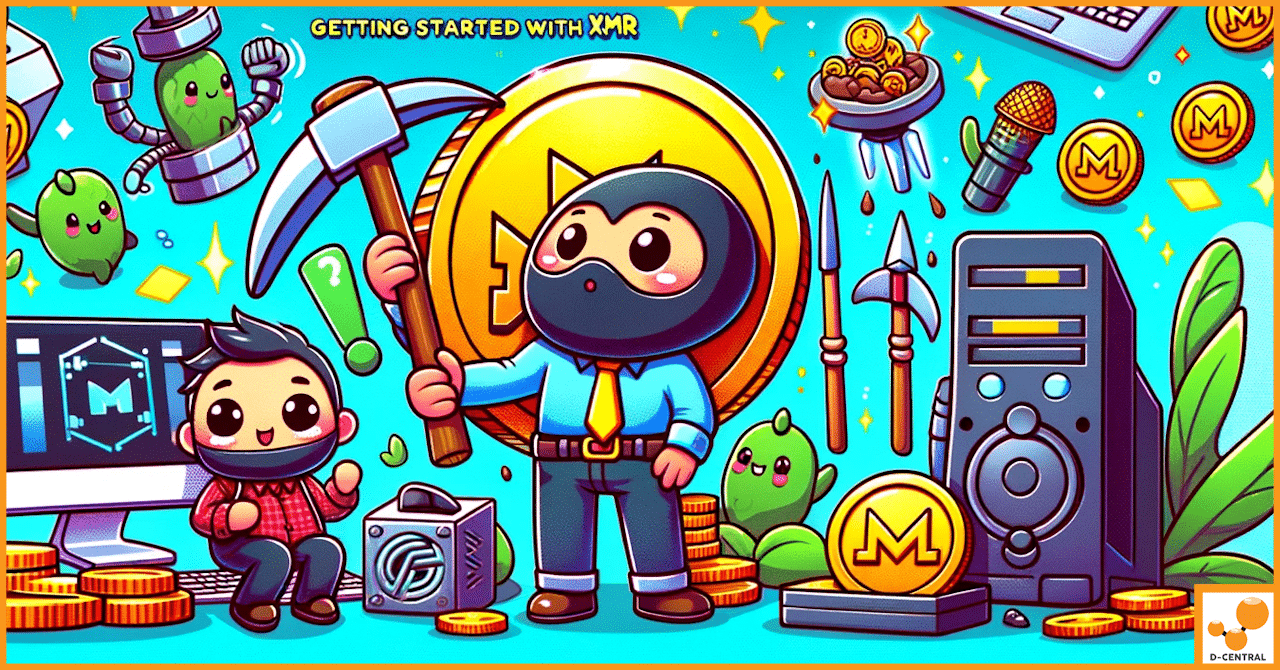
Will History Repeat Itself? Understanding Aggregate Price Levels After Major Events
Are you wondering if history is destined to repeat itself? The answer may lie in understanding aggregate price levels after
4479 Desserte Nord Autoroute 440, Laval, QC H7P 6E2

In the ever-evolving landscape of cryptocurrency, Monero (XMR) has carved out a unique niche, distinguishing itself as a standard-bearer for privacy and anonymity. Since its inception in 2014, Monero has consistently grown in popularity and respect, emerging as a pivotal player in the world of digital currencies. Unlike many of its contemporaries, Monero is not just another iteration on the blockchain theme; it represents a fundamental shift towards a more secure and private means of digital transaction.
The rise of privacy-focused digital currencies like Monero marks a significant turning point in the crypto sphere. In an era where digital footprints are scrutinized, and personal data is often commoditized, Monero offers a refreshing alternative. It champions the ethos of privacy, ensuring that users’ identities and transaction details remain confidential and shielded from public view. This focus on privacy is not just a feature of Monero; it is the very foundation upon which it is built.
As we delve into the world of Monero mining, this article aims to provide a comprehensive guide that covers every facet of this intriguing process. From the technical intricacies of Monero’s blockchain to the practical steps involved in mining this cryptocurrency, we will explore the nuances that make Monero a unique and compelling choice for miners and investors alike. Whether you are a seasoned miner or new to the world of cryptocurrency, this guide is designed to offer valuable insights into the world of Monero mining, underscoring its significance in the broader context of digital currencies.
In the following sections, we will navigate through the technical landscape of Monero, demystify its mining process, and provide practical advice for those looking to embark on their Monero mining journey. Join us as we uncover the secrets of Monero mining and reveal why it continues to be a beacon of privacy in the digital age.
Monero’s journey began in April 2014, born out of a fork of the Bytecoin blockchain, a cryptocurrency also focused on privacy. The inception of Monero was driven by the desire to address several perceived flaws in Bytecoin, particularly around its opaque pre-mining history. Monero, initially known as BitMonero, quickly garnered attention and support for its enhanced approach to privacy and security. Over the years, Monero has undergone several significant updates, including the adoption of the CryptoNote protocol, which introduced ring signatures and stealth addresses to further anonymize transactions.
The development of Monero has been marked by a strong commitment to decentralization and community involvement. Unlike many other cryptocurrencies, Monero is predominantly driven by volunteer work and community funding, reflecting its grassroots origins. This approach has fostered a robust and dedicated community, continually working towards improving Monero’s privacy features and overall functionality.
The cornerstone of Monero’s appeal lies in its unparalleled focus on privacy, security, and untraceability:
When compared to other major cryptocurrencies like Bitcoin, Monero stands out primarily due to its privacy features. While Bitcoin transactions are pseudonymous and traceable on a public ledger, Monero transactions remain hidden, offering true anonymity. This distinction has made Monero a preferred choice for users who prioritize privacy in their transactions.
Moreover, Monero’s egalitarian mining process allows for a more decentralized mining community. Unlike Bitcoin, which requires specialized hardware (ASICs) for effective mining, Monero can be mined using standard computer hardware, making it more accessible to a broader range of individuals.
Monero’s commitment to privacy, security, and untraceability, combined with its unique mining process, sets it apart in the crowded field of cryptocurrencies. Its evolution and continued development reflect a focused effort to maintain these core values, making it a standout choice for users who value privacy above all else in their digital transactions.
In the realm of cryptocurrencies, mining is the process by which transactions are verified and added to the blockchain ledger. It involves solving complex cryptographic puzzles that require computational power. Miners compete to solve these puzzles, and the first to succeed is rewarded with a certain amount of the cryptocurrency. This process not only validates and secures transactions but also plays a crucial role in the creation of new coins, contributing to the overall supply of the cryptocurrency.
Mining serves a dual purpose: it is the means by which new cryptocurrency tokens are created (akin to gold mining, hence the term), and it is also a critical component of the maintenance and development of the blockchain ledger. It is a decentralized process, ensuring that no single entity has control over the blockchain.
Monero, like Bitcoin, employs a consensus mechanism known as Proof-of-Work (PoW). However, Monero’s approach to PoW is distinct in its design and objectives. The primary goal of Monero’s PoW is to facilitate a more egalitarian mining process, allowing individuals with consumer-grade hardware to participate effectively. This is in contrast to Bitcoin, where mining has become largely centralized due to the dominance of specialized mining hardware (ASICs).
Monero’s PoW mechanism is designed to be ASIC-resistant, meaning it discourages the use of these specialized mining rigs. This resistance is crucial for maintaining Monero’s decentralized mining community, ensuring that mining power is not concentrated in the hands of a few large-scale mining operations.
The introduction of the RandomX algorithm marked a significant shift in Monero’s mining landscape. RandomX replaced the previous CryptNight algorithm in late 2019, further advancing Monero’s ASIC-resistant strategy. This change was a response to the growing concern that ASIC miners were beginning to dominate Monero mining, potentially threatening its decentralized nature.
RandomX is optimized for general-purpose CPUs, meaning that everyday computers used by most people are suitable for mining Monero. This shift has significant implications for the mining community, as it lowers the entry barriers, allowing more individuals to participate in Monero mining. It democratizes the mining process, aligning with Monero’s philosophy of equal and fair access to mining.
The impact of RandomX on Monero mining has been profound. It has reinforced Monero’s commitment to decentralization and egalitarianism in cryptocurrency mining. By making mining accessible to a broader audience, Monero not only strengthens its network but also stays true to its core principle of providing privacy and security in a decentralized manner.
The technical aspects of Monero mining, from its basic principles to the sophisticated RandomX algorithm, are designed to uphold the cryptocurrency’s commitment to privacy, security, and decentralization. These features set Monero apart in the cryptocurrency world and define its unique position in the market.
Monero mining is a fascinating process that involves several key steps. Here’s a simplified guide on how it operates:
For Monero mining, the choice of hardware and software is crucial:
Monero miners can choose between solo mining and joining a mining pool:
In summary, Monero mining is an accessible process that can be undertaken with standard computer hardware. The choice between solo mining and pool mining depends on the miner’s resources and preferences. With the right setup and approach, Monero mining can be a rewarding endeavor, contributing to the strength and security of the Monero network.
The choice of hardware is a critical first step in Monero mining. Here are some recommendations:
Setting up mining software is a straightforward process. Using XMRig as an example, here’s a detailed guide:
config.json file with a text editor to configure your mining settings. Key configurations include:
Mining pools increase your chances of earning rewards. Here’s how to choose and join one:
By carefully selecting the right hardware and setting up your mining software, you can optimize your Monero mining operation. Joining a mining pool can further enhance your chances of earning Monero, making the mining process more rewarding and efficient.
When it comes to storing Monero (XMR), there are several types of wallets to choose from, each offering different features and levels of security:
Here’s a step-by-step guide for beginners to set up a Monero wallet, using the Monero GUI wallet as an example:
By following these steps, you can set up a Monero wallet that suits your needs, whether for everyday transactions or long-term storage. Remember, the security of your Monero depends on how safely you store your mnemonic seed and password.
The profitability of Monero mining is influenced by several key factors:
Tools like Monero mining calculators can help estimate profitability by considering these factors. You input your hardware’s hash rate, power consumption, electricity cost, and the calculator estimates potential earnings.
Monero mining faces several challenges:
Solutions:
Monero introduces a concept known as “tail emission” in its reward system. Unlike Bitcoin, which has a capped supply, Monero will continue to create new XMR indefinitely. Once the main supply of Monero is mined (approximately 18.4 million XMR), the tail emission kicks in, providing a small, steady reward of 0.6 XMR per block. This system is designed to:
Understanding these aspects of Monero mining is crucial for anyone considering entering this space. While there are challenges, strategic planning and a thorough understanding of the mining process and its economics can lead to a rewarding experience.
The legal aspects of Monero mining and usage vary significantly across different regions, reflecting the diverse approaches governments take towards cryptocurrencies:
It’s crucial for miners to stay informed about the legal status of cryptocurrencies in their respective regions and comply with all relevant laws and regulations.
Privacy coins like Monero often face ethical scrutiny due to their potential misuse:
Navigating the legal and ethical landscape of Monero mining requires a careful understanding of both regional regulations and the broader implications of using a privacy-focused cryptocurrency. Staying informed and engaged with the ongoing discussions in the crypto space is essential for responsible participation in the Monero ecosystem.
As we conclude our comprehensive journey through the world of Monero mining, it’s clear that while D-Central Technologies primarily focuses on Bitcoin, the undeniable market adoption and unique attributes of Monero warrant recognition and understanding.
Monero, with its steadfast commitment to privacy and security, stands as a beacon in the cryptocurrency landscape. Its distinguishing features, such as the implementation of the RandomX algorithm and the emphasis on CPU-based mining, democratize the mining process, making it accessible to a broader audience. This approach not only reinforces the decentralized ethos of cryptocurrency but also aligns with the growing global consciousness around privacy and data security.
Throughout this article, we have navigated the technicalities of Monero’s mining process, from the nuances of its Proof-of-Work mechanism to the practicalities of setting up mining hardware and software. The exploration of mining pools versus solo mining, along with the detailed guide on Monero wallets, provides a foundation for both new and experienced miners to engage with Monero mining effectively.
While D-Central Technologies is renowned for its expertise in Bitcoin mining, the exploration of Monero mining highlights the diversity and richness of the cryptocurrency world. Monero’s unique position, particularly in terms of privacy, adds a valuable dimension to the broader conversation about the future of cryptocurrencies and their impact on society.
The importance and potential of Monero mining extend beyond immediate financial gains. It represents a commitment to upholding privacy in the digital age, a principle that is increasingly becoming a cornerstone in the world of cryptocurrency. As the landscape evolves, the insights gained from understanding Monero’s approach can enrich our perspective on the future of digital currencies.
For those intrigued by the world of cryptocurrency beyond Bitcoin, Monero presents a compelling avenue. While D-Central Technologies remains a leader in Bitcoin mining, the exploration of Monero mining underscores the importance of staying informed and versatile in the ever-evolving cryptocurrency domain.
What is Monero (XMR)?
Monero (XMR) is a privacy-focused cryptocurrency that ensures users’ identities and transaction details remain confidential. It was launched in 2014 and is built on the principles of privacy, security, and untraceability.
How does Monero differ from other cryptocurrencies like Bitcoin?
Monero stands out primarily due to its advanced privacy features. Transactions are obscured to prevent traceability, a stark contrast to the transparent nature of Bitcoin’s blockchain. Moreover, Monero uses an egalitarian mining process that is more accessible to individual miners without specialized hardware.
What is RandomX?
RandomX is the mining algorithm used by Monero, designed to be ASIC-resistant and optimized for general-purpose CPUs. It replaced the previous CryptNight algorithm and democratizes the mining process by allowing more individuals to participate with everyday computer hardware.
Can I mine Monero using standard computer hardware?
Yes, you can mine Monero using standard computer hardware. Monero’s RandomX algorithm is particularly favorable for CPUs, and even though GPUs can be used, CPUs are generally more efficient for Monero mining.
What are the advantages of joining a Monero mining pool?
Joining a Monero mining pool can increase the chances of earning rewards, as miners combine their computational power for a higher probability of mining blocks. Rewards are more consistent and frequent in pools, although they are shared among pool members, and pools usually charge a fee.
What are the key factors affecting the profitability of Monero mining?
The profitability of Monero mining is influenced by hardware efficiency, electricity costs, mining pool fees, the network’s mining difficulty, and the market price of Monero.
What is Monero’s ‘tail emission’?
Monero’s ‘tail emission’ is a continuous, small reward of 0.6 XMR per block that kicks in once the main supply of Monero is mined. It ensures miners remain incentivized, helps combat deflation, and supports the long-term sustainability of Monero mining.
What are the legal and ethical considerations surrounding Monero mining?
The legality of Monero mining varies by country, with some regions imposing strict regulations or outright bans, while others are more crypto-friendly. Ethical considerations include the balance between privacy and transparency and the responsibility to counteract the potential misuse of privacy coins like Monero.
How do I set up a Monero wallet?
To set up a Monero wallet, download the wallet software suitable for your operating system, create a new wallet, record the mnemonic seed in a safe place, set a strong password, synchronize with the blockchain, and use your Monero address to receive funds.
Where can I learn more about Monero mining?
You can learn more about Monero mining through community forums, official Monero documentation, and educational resources that explain the technical aspects, mining process, and economics of Monero.
DISCLAIMER: D-Central Technologies and its associated content, including this blog, do not serve as financial advisors or official investment advisors. The insights and opinions shared here or by any guests featured in our content are provided purely for informational and educational purposes. Such communications should not be interpreted as financial, investment, legal, tax, or any form of specific advice. We are committed to advancing the knowledge and understanding of Bitcoin and its potential impact on society. However, we urge our community to proceed with caution and informed judgment in all related endeavors.
Related Posts

Are you wondering if history is destined to repeat itself? The answer may lie in understanding aggregate price levels after

Bitcoin, the first and most widely recognized cryptocurrency, has transformed the financial landscape since its creation in 2009. At the

Discover how cutting-edge mining hardware can transform your operations, increase profitability, and optimize energy usage in the ever-evolving world of